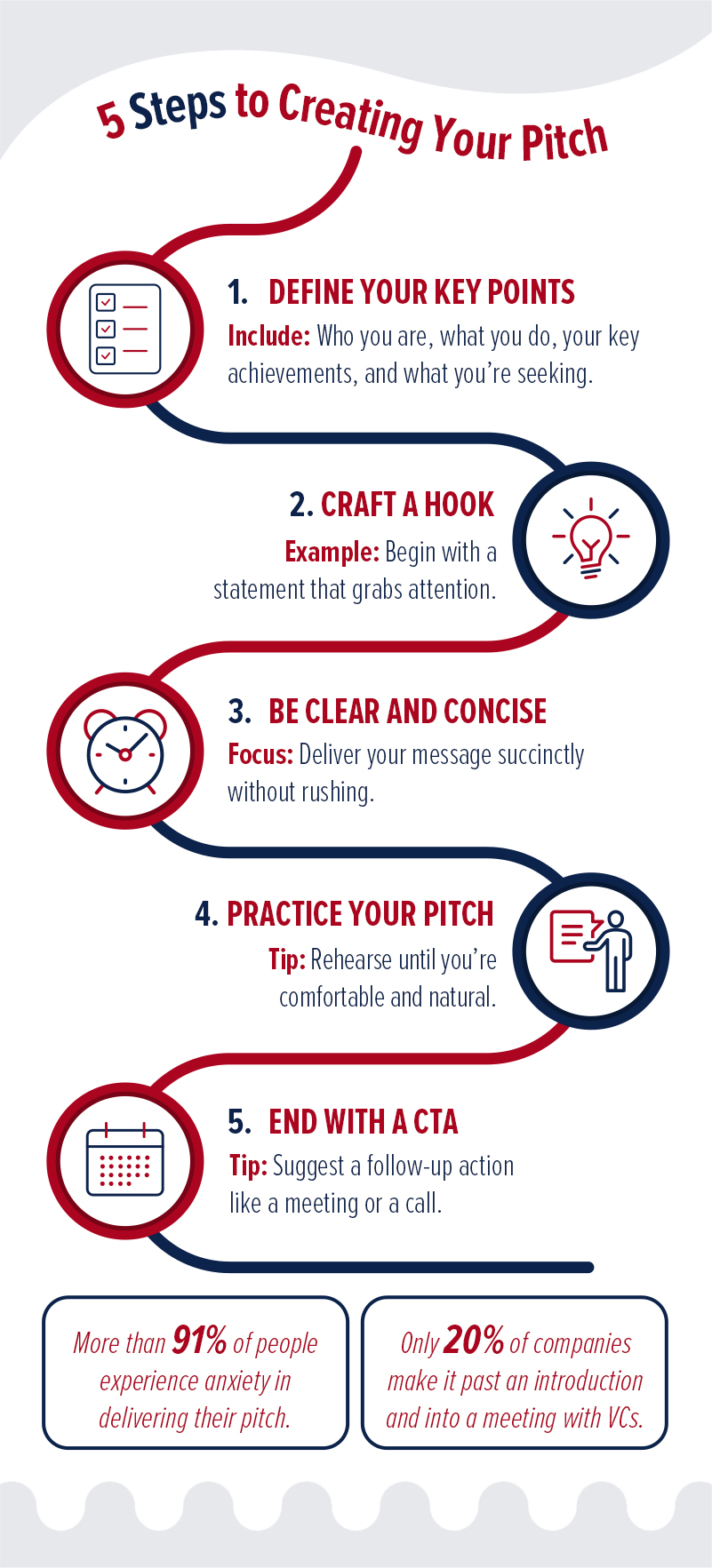What is an elevator pitch? If you’re looking for the answer to that question, you’ve come to the right place. Consider this article your guide to creating the perfect elevator pitch. Once you understand the purpose of an elevator pitch, you’ll understand why it’s important in business and social settings, how to develop your own pitch, and, most importantly, how to make it memorable and leave them wanting to hear more.
In this blog, we will go over the following information:
- Defining an elevator pitch
- Elements of an elevator pitch
- Five simple steps to creating your elevator pitch
- How to leave them wanting more
- Why a student should have an elevator pitch
- Tips for a successful elevator pitch
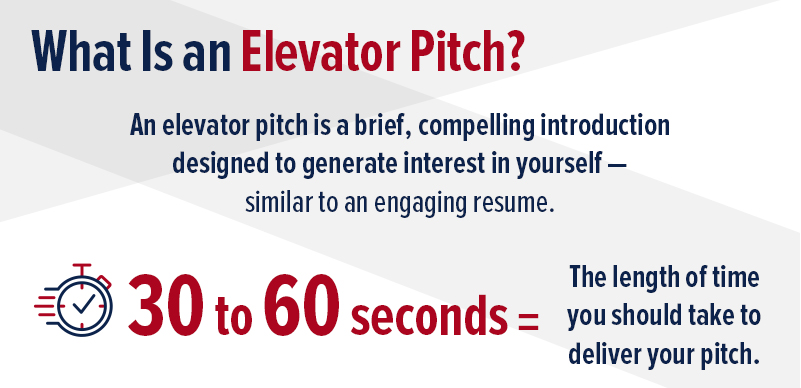
Defining an Elevator Pitch
If you’ve read this far, that means the opening paragraph achieved its goal, and that’s the same purpose as an elevator pitch: generate excitement. Your elevator pitch should generate excitement and interest in you in a brief, easily understood manner that leaves your audience wanting more.
Think of the elevator pitch as a slimmed-down version of your resume and cover letter. If you’re networking your way into a new job or a new industry, the elevator pitch can be one of the most effective strategies for defining your skills, expertise, and goals. The name itself springs from the idea that you have a limited amount of time – a 30- to 60-second elevator ride, for example – to make an impressive and memorable pitch.
The elevator pitch has been employed as a sales tactic for decades, but it’s worth noting that an elevator pitch is different from a sales pitch. Yes, you are selling yourself, but the “buyer” in the scenario isn’t necessarily buying. Your pitch needs to convince a prospective employer or connection that you’re worth hearing and remembering. You want to leave an impression that makes them want to learn more about you.
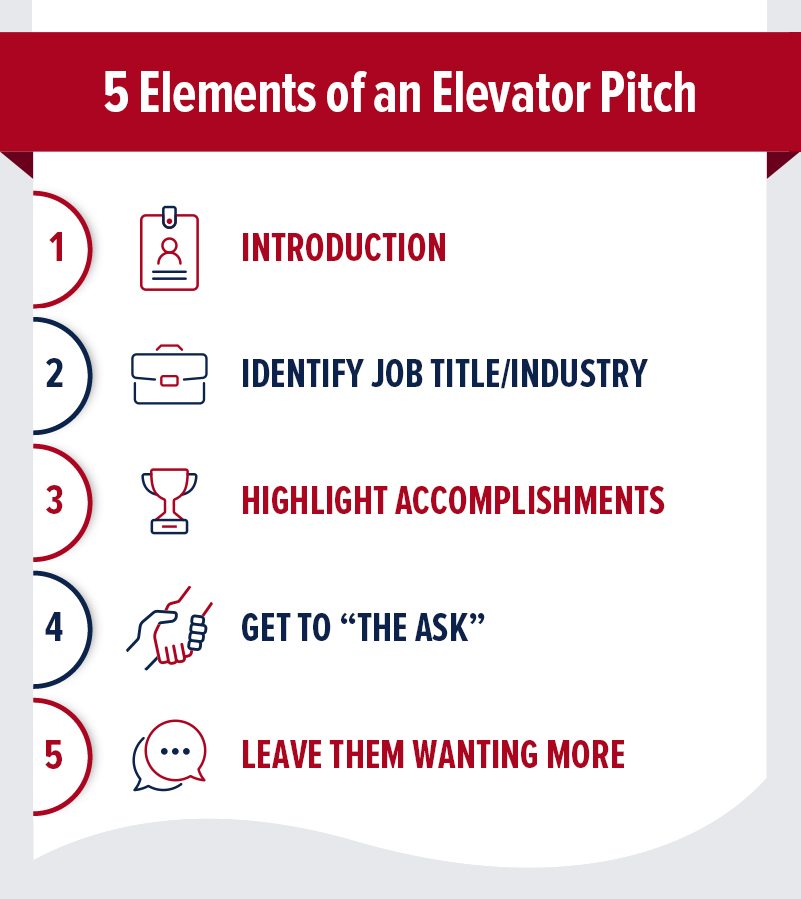
Elements of an Elevator Pitch
What makes an elevator pitch ideal? It should succinctly answer the questions that a potential employer, recruiter, or contact may have about you:
- Who are you?
- What is your expertise?
- What are your accomplishments?
- What are your goals?
- Why should I hire or refer you?
Whether you’re graduating from college or have been working for decades, your elevator pitch will be comprised of five simple steps – think of them as boxes on a form you’re filling out. You want to check all the boxes, but ensure that you’re not going over your allotted time.
Every elevator pitch is different in the details, so for the purposes of this list, think about the highlights of your life and career you would include.
1. Introduce yourself
First and foremost, you want to tell the person you’re pitching to who you are. If you have some familiarity with the person, you can remind them.
Example: “Good morning, I’m Lucy Salt, pleasure to meet you. I saw you speak at the conference last year, great to run into you here.”
2. Identify your job title, company, or industry
Given your limited time, you’ll want to get right into explaining what you do. You can use your resume and cover letter to prepare for this step, or simply write down in paragraphs what you do for a living, what your areas of expertise are, and which companies you’ve worked for in your career.
When you have all your work experience written down and in some form, go through it and excise anything that’s not critically important to your elevator pitch. You want to specifically focus on what you do without taking too long or getting into unnecessary details.
Example: “Hello, it’s very nice to meet you, I’m Lucy Salt. I’m a marketing professional and I’ve spent the past year as a copywriter for Company X after graduating with my bachelor’s degree in business administration from the University of Arizona Global Campus.”
3. Highlight your accomplishments
Just like the previous step, you’ll want to put all of your achievements on one document and then edit it down to those vital to your elevator pitch. Essential details will highlight your strengths and skills, while non-essentials are details that no one needs to hear immediately.
For example, being named “Employee of the Month” is an achievement, but not one that’s necessary for your elevator pitch. Instead, you might want to focus on what you did to earn the title. A potential employer is much more interested in how your talent can be used for their benefit.
Example: “Hello, it’s very nice to meet you, I’m Lucy Salt. I’m a marketing professional and I’ve spent the past year as a copywriter for Company X after graduating with my bachelor’s degree in business administration from the University of Arizona Global Campus. It’s been a great experience and I’ve been able to draft digital marketing campaigns for many of our clients. My strength is writing B2B content and developing B2B social media strategy.”
4. Get to “The Ask”
One of the most challenging elements of the elevator pitch is the bottom line. Surely, you and the person you’re pitching yourself to know you want something from the conversation, and this step can be very difficult for anyone who’s not used to promoting themselves to strangers.
It doesn’t have to be that hard. When preparing, practice what you want to say — specifically, how your talent would be of value to the person you’re pitching to at the company. You’ve already explained who you are and what you do, now think about what you can do for them and why you think your skills align with their company’s mission. Show the person you’re pitching to that you:
a. Have a genuine interest in their company or industry
b. Have a passion for the work you do
c. Have ideas that could benefit a future employer
d. Have already begun making plans for your future
Example: “Hello, it’s very nice to meet you, I’m Lucy Salt. I’m a marketing professional and I’ve spent the past year as a copywriter for Company X after graduating with my bachelor’s degree in business administration. It’s been a great experience and I’ve been able to draft digital marketing campaigns for many of our clients – my strength is writing B2B content and developing B2B social media strategy.
That’s why it’s great to run into you, because I’ve always admired how your company uses engaging social media content — specifically Instagram — to connect with prospects. That’s a part of the business that really excites me, and I’ve been developing my own B2B social media strategy guides that would be useful to a company in your position in hopes that I can transition to a new role in the future.”
5. Leave them wanting more
As you wrap your pitch, don’t be shy about showing some emotion, within reason, of course. If you’re presenting yourself with a smile and a real confidence about yourself and your potential, let the person see it in your expressions, body language, and more.
You’ll want to end the conversation with a Call to Action (CTA), so the person you’re pitching to has an idea of what you want and how they can connect with you. The CTA can be as intimidating, if not more than “The Ask,” but a surefire way to move things forward is to put the next step on you. Rather than passing along your contact information and hoping for the best, try to arrange for another meeting to take the conversation further.
Example: “Hello, it’s very nice to meet you, I’m Lucy Salt. I’m a marketing professional and I’ve spent the last year as a copywriter for Company X after graduating with my bachelor’s degree in business administration. It’s been a great experience and I’ve been able to draft digital marketing campaigns for many of our clients – my strength is writing B2B content and social media strategy.
That’s why it’s great to run into you, because I’ve always admired how your company uses engaging social media content – specifically Instagram – to connect with prospects. That’s a part of the business that really excites me, and I’ve been developing my own B2B social media strategy guides that would be useful to a company in your position in hopes that I can transition to a new role in the future. I’d love to talk further about an opportunity to join forces. Would you have time to connect on a call next week, or I’d be happy to meet you somewhere close to your office for a face-to-face meeting?”
If you’ve successfully followed each step, you can walk away from your encounter knowing you presented yourself in your best light. You will ensure the person you’ve pitched to knows you a) are serious about taking the next step forward in your career, b) have a grasp on what their company does and how you could fit in, and c) have the confidence and the skills it takes to succeed.
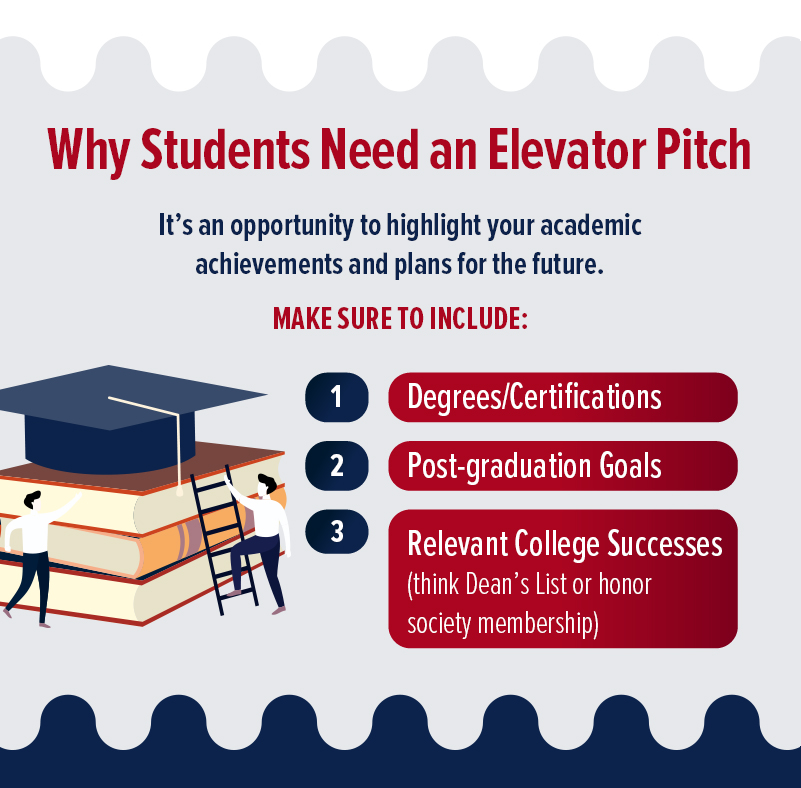
Why a Student Should Have an Elevator Pitch
The idea of an elevator pitch can be challenging for you to wrap your head around as a student, because you may feel you don’t have enough professional experience or any accomplishments to “boast” about. But that shouldn’t deter you from developing your own pitch to a potential employer or contact. For a student, an elevator pitch can include details about your degree and post-graduation goals, as well as relevant college experience and academic achievements that demonstrate your skill level and how you’re using those skills in your current career.
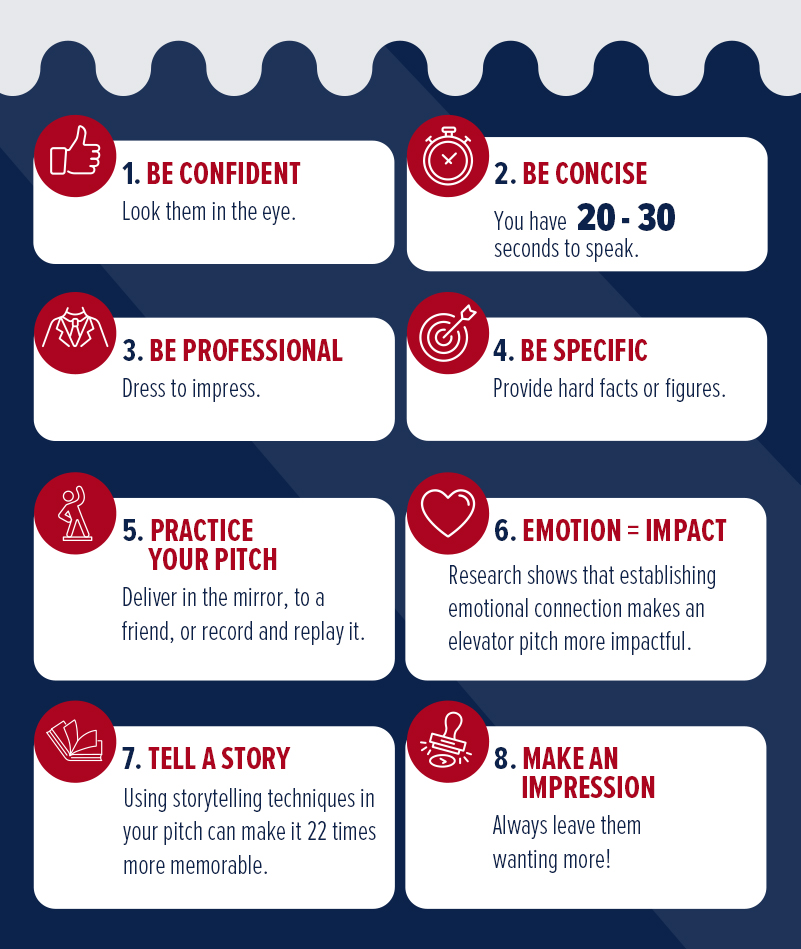
5 Tips for a Successful Elevator Pitch
While the details of your elevator pitch may change depending on who you’re speaking to and where you are in your academic or professional career, some things never change. Keep the following tips in mind when formulating your elevator pitch.
1. Be confident (but not overconfident)
You want your audience to recognize that you’re confident enough to take the first step in a relationship-building setting.
2. Be concise (but don’t rush)
It’s perfectly normal to have anxiety in an elevator pitch scenario, but you want to avoid rushing through everything just to get it over with and avoid rambling. Be specific about your intent, speak calmly and conversationally, and always remember that details matter.
3. Be professional (but avoid being too personal)
The person you’re pitching doesn’t need to know the specifics of why you want to leave your current position. So, no matter how dissatisfied you may be with aspects of your job, leave those details out of your elevator pitch. They only need to know that you are interested in bringing value to their company.
4. Be specific (but avoid generalizations or clichés)
While it’s tempting to fall back on clichés to describe yourself or your work, you want to be as specific as possible in your elevator pitch. You don’t need to overload your pitch with buzzwords — just speak specifically about your expertise. This will further convey that you know what you’re talking about, and aren’t just relying on jargon to make an impression.
5. Practice Your Pitch
Perhaps above anything else, your elevator pitch needs practice. Write it and rewrite it as often as you can until you’re completely comfortable with what you’re saying. Then, try practicing in front of a mirror, or call a colleague and ask if they can stand in and hear your pitch as if they were a potential employer. The more you commit to perfecting your pitch, the more success you’ll have when it’s time to use it.
Infographic | How to Write an Elevator Pitch

--
Written by University Staff

